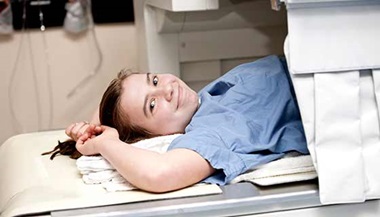Peroral Endoscopic Myotomy (POEM)
POEM is a procedure to treat problems with the muscles in the esophagus, which is the passageway between the mouth and stomach.
What You Need to Know
- POEM can be a treatment option for people with muscle disorders in the esophagus, such as achalasia.
- POEM generally takes up to one hour and is performed under general anesthesia.
- It is minimally invasive and leaves no visible scars.
- After the procedure, the care team will monitor your recovery while the sedative wears off. POEM can be done as an outpatient procedure, or it may require an overnight hospital stay.
- POEM is about 90% effective in relieving esophageal spasms.
What is peroral endoscopic myotomy (POEM)?
Peroral endoscopic myotomy is a procedure to treat swallowing disorders caused by muscle problems such as spasms in the esophagus. POEM uses an endoscope — a narrow flexible tube with a camera — that is inserted through the mouth (peroral) to cut muscles in the esophagus (a myotomy). Cutting the muscles loosens them and prevents them from tightening and interfering with swallowing.
POEM is not considered a surgery, since no incision is made through the skin. It is a less invasive alternative to Heller myotomy — a similar procedure that uses small incisions to reach the esophagus instead of access through the mouth. Endoscopic procedures often mean less pain and a faster recovery than open surgical procedures.
Peroral Endoscopic Myotomy (POEM) | Q&A
Who may need a POEM procedure?
POEM is mainly used to treat achalasia, an excessive tightness of the ring of muscle (sphincter) between the esophagus and the stomach. For people with esophageal achalasia, this muscle doesn’t relax, and other esophagus muscles don’t help move swallowed food down, preventing it from entering the stomach. This can cause coughing or choking, sore throat, food becoming trapped in the esophagus, and even weight loss and nutrient deficiencies.
Many people who experience low quality of life due to achalasia symptoms are candidates for POEM. The procedure helps relieve achalasia by cutting the muscles in the lower part of the esophagus, around the sphincter and in the upper stomach. This helps widen the space for food to pass into the stomach.
POEM can also address other disorders that cause spasms in the esophagus and that do not respond to drug treatment, such as diffuse esophageal spasm and nutcracker or jackhammer esophagus.
Children and adults can have POEM — age is usually not a major factor. Underlying conditions such as heart and lung problems can make the procedure unsafe. If you have these conditions, the gastroenterologist may ask you to get evaluated by an anesthesiologist before proceeding with POEM.
Previous surgeries on the esophagus may make POEM complicated or less effective. Your doctor will discuss with you whether POEM is the best option for you in this case.
Cutting Edge Treatment for Achalasia — POEM Procedure
Preparing for the POEM Procedure
Your doctor will give you specific instructions on how to prepare for the POEM procedure. Preparation will likely include a liquid diet for a couple of days and a fasting period the day before the procedure.
Tell your doctor about any allergies you have and all the medications and supplements you take. Your doctor will let you know if, when and how to take your medicines right before the POEM procedure.
You may be scheduled to arrive at the treatment center several hours before the procedure begins. Most patients can go home after the procedure, however, some require an overnight stay. Your doctor will discuss this with you before the procedure and during your recovery.
Make sure a responsible adult can take you home after the procedure, since you might be drowsy from anesthesia.
What happens during the POEM procedure?
- An IV will be inserted into your vein to give you fluids, anesthesia and antibiotics.
- Once you are asleep from the anesthesia, your doctor will pass the endoscope through the mouth and into the esophagus, and will view the images of the inside of the esophagus on a nearby monitor.
- The doctor will insert instruments through the endoscope to make a small cut in the lining of the lower esophagus. A liquid solution is injected into this opening, and the endoscope works its way through to separate the lining from the muscle.
- The doctor will then perform a myotomy (cutting of muscle) along the tunnel that was created. The muscle is cut in the lower esophagus, the sphincter between the esophagus and the stomach, and in the upper part of the stomach.
- The doctor will use the endoscope to close the incision in the esophageal lining with small clips.
Recovery After the POEM Procedure
When the procedure is finished, you will recover from the anesthesia in the endoscopy unit. When you are awake, your doctor will discuss the results with you. Some patients need to spend a night or two in the hospital following POEM for observation and testing. Your doctor will let you know when you can go home and when to resume your regular diet. Your throat may be sore for a few days after the procedure.
POEM Risks and Complications
Because the procedure is minimally invasive, POEM is regarded as safe. Complications are rare, but possible, including:
- Inflammation of the esophagus
- Gastroesophageal reflux disease (GERD)
- Infection
- Bleeding due to injury to the esophagus
- Collapsed lung (pneumothorax)
- An air bubble in the peritoneal cavity (pneumoperitoneum) or between the lungs (pneumomediastinum)








